Answer these simple questions and we will find you the BEST prices
Which type of solar quotes do you need?
It only takes 30 seconds
100% free with no obligation

Get Free quotes from insulation specialists near you

Save money by comparing quotes and choosing the most competitive offer

The service is 100% free and with no obligation
- GreenMatch
- Insulation
- Wall Insulation
- Wall Insulation Costs
How Much Does Wall Insulation Cost?

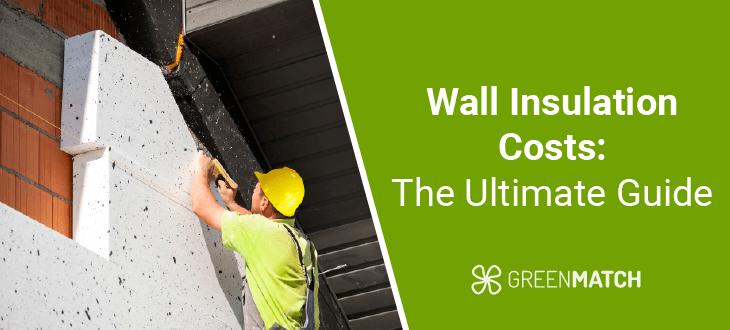
- Homes can lose up to one-third of their heat just through uninsulated walls.
- Wall insulation for an average 3-bedroom semi-detached house in the UK costs around £2700.
- Two UK schemes are active until March 2026 to assist qualifying households with wall insulation grants.
Wall insulation is arguably the most effective measure any household can take in boosting their energy efficiency. It helps to considerably slow down heat loss occurring in your home, leading to huge CO2 reductions of around 0.6 - 0.8 tonnes every year, and big annual savings of up to £235 in a semi-detached UK house.
Like with any big investment, homeowners want to know whether wall insulation is a home upgrade worth their money. The answer is a resounding yes!
In this ultimate guide, we’ll take you through everything you need about wall insulation, including costs, savings, and grants you may be eligible for.
Can't wait any longer? Let GreenMatch UK land you the best deals in wall insulation. Instead of spending hours on end surfing websites and making phone calls, just spend 30 seconds filling out our online form and receive up to 3 free quotes from trusted installers in your area. No charges or obligations apply. Click below to begin!
- Describe your needs
- Get free quotes
- Choose the best offer
It only takes 30 seconds



Average wall insulation prices
Average wall insulation prices for a standard 3-bedroom semi-detached house in the UK normally sit at around £2700 for cavity wall insulation, and around £7,500 - £13,000 for solid wall insulation, depending on whether you do internal or external insulation.
Wall insulation prices aren’t easy to predict and can vary significantly based on various factors. Before delving into costs, here are some key factors that can play a role in your final investment:
- Wall type: Whether your home has solid or cavity walls will play a big role in determining your house insulation cost. Generally speaking, solid wall insulation costs more than cavity wall insulation.
- Home size: While it may seem obvious, a bigger home with more walls will cost more to insulate than smaller homes or flats. We’ll break down costs per home type later on in the article.
- Insulation material: There are many insulation materials on the market, each with suited purposes, efficiency, and points to consider. The best material for your wall insulation will hinge on several factors, including your budget and personal preferences.
- Labour costs: While labour costs are quite standard, they fluctuate depending on where you are. Dense urban areas and larger cities like London will inevitably have higher labour costs than suburban or rural areas.
The UK also assists certain households with two key grant schemes that you may be eligible for based on a series of qualifications. These grants can significantly reduce or even get rid of all your potential costs. We’ll discuss currently available grants later in this article.
Cavity wall insulation cost
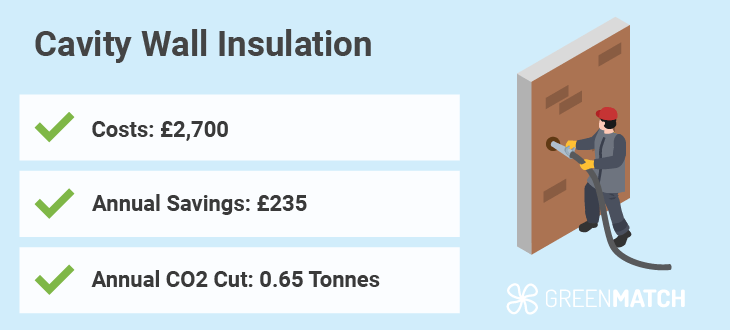
If you’re wondering how much is cavity wall insulation, the job in a 3-bedroom semi-detached house in the UK can cost around £2700. Cavity walls are a commonly found building style in the UK, typical in homes built after the 1920s and making up over 75% of all properties.
This style consists of two separate walls, typically an outer brick wall and an inner concrete wall, with a hollow space (cavity) in between. This design offers enhanced structural stability and seamless insulation by filling material directly into the cavity space.
Keep in mind that the average cost of cavity wall insulation may fluctuate depending on home size, type and location. Let's start by having a look at typical cavity wall insulation costs in the UK based on the type of home you have:
| Home type | Cavity wall insulation cost | Yearly energy savings |
|---|---|---|
| Flat / Apartment | £1000 | £110 |
| Semi-detached home | £2700 | £235 |
| Detached home | £4600 | £406 |
| Mid terrace home | £1500 | £140 |
| Detached bungalow | £2100 | £175 |
Solid wall insulation cost
Solid wall insulation costs can typically range between £7,500 - £13,000 based on whether you opt for internal or external wall insulation. There's no one-size-fits-all answer, as factors like house size, wall condition, and installation complexity will play a role in your investment.
Solid walls are a hallmark of pre-1920s construction in the UK, making up just under 30% of all existing properties. These walls consist of a single or double layer of brick with no air gap in between. While they offer a sense of elegance, an astonishing 97% of such properties lack insulation, leading to discomfort and high energy bills.
Unlike cavity walls, solid walls have no cavity space. This means insulation needs to be added either internally or externally, making the process more complex than cavity wall insulation.
While these upfront costs may seem daunting, the benefits are noteworthy. A semi-detached UK home can cut annual carbon emissions by up to 0.9 tonnes and rack in up to £380 in yearly energy bill savings.
External wall insulation cost
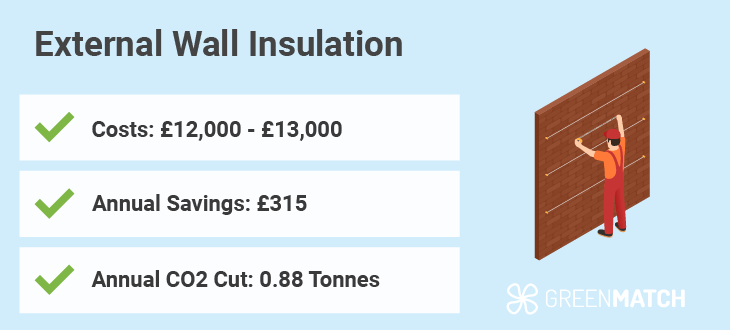
External wall insulation is generally a more expensive process, with the Royal Institution of Chartered Surveyors (RICS) estimating an average of £13,000, and Energy Saving Trust suggesting a slightly lower £12,000 for a full job.
Insulating external walls involves placing insulation material - like rigid (sheet) insulation boards - directly onto the outer walls of your home. These are then covered with plasterwork, render and external insulation cladding to protect them from moisture and weather damage.
The average cost of external wall insulation can fluctuate greatly based on your home size, type, location, and installation complexity. Consulting with a professional installer can give you the most accurate estimate of what to expect.
Internal wall insulation cost
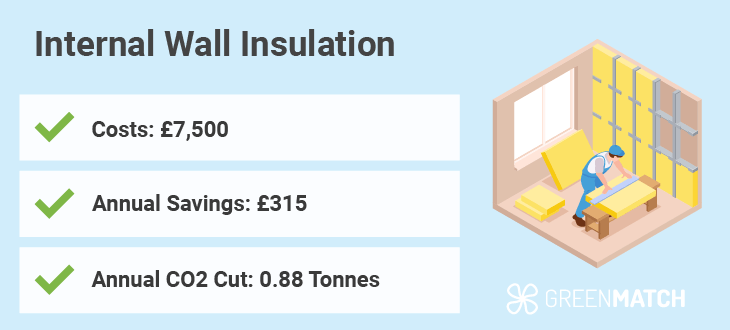
Internal wall insulation is a more cost-effective way to improve your home's energy efficiency than external wall insulation. A full internal wall insulation cost sits around £7,500, according to estimates from both RICS and Energy Saving Trust.
Typically, there are two main methods for internal wall insulation, and your prices may fluctuate depending on which approach you opt for:
- Dry lining: Rigid insulation boards are directly fixed to your existing walls and then covered with plasterboard for a smooth finish.
- Stud walls: A timber or metal frame is built out from the existing wall, creating a cavity. This cavity is then filled with insulation materials like mineral wool, fibreglass rolls, or even sheep wool. Finally, the plasterboard is fixed to the frame to create a ‘stud’ wall.
Typically, the cheapest way to insulate internal walls would be dry-lining if you don't have stud walls in place. Keep in mind that the cost of internal wall insulation here assumes a full job, complete with material, labour and home redecoration. However, there are some extra steps you can take to reduce your costs further:
- Timing: Start a wall insulation project alongside other building, repair, or decoration work on your home. That way, most of your home will be cleared and prepped for a job to take place. There may also be scaffolding in place that can cut costs.
- One room at a time: You don’t have to do a full home insulation in just one go. You can prioritise insulating room by room. This mostly refers to internal wall insulation, but it can help spread out costs and make them more manageable.
Are you eligible for insulation grants?
In a bid to become carbon neutral by 2050, the UK government has backed two key grant schemes that are active until March 2026. These are the Great British Insulation Scheme and the ECO4 Scheme (Energy Company Obligation).
These aim to assist energy-inefficient and fuel-poor households across the country with grants for wall insulation projects, alongside a whole host of other home efficiency improvements aimed at reducing the overall carbon footprint of domestic housing.
Let’s take a closer look at what each scheme has to offer:
- The Great British Insulation Scheme provides qualifying homes with single insulation measures, including solid and cavity wall insulation grants. This one-per-household approach enables the scheme to target a wider range of homes across the UK. Upgrades are decided after a home assessment to identify the most effective measure. The scheme can be directly applied via the official UK government portal.
- The ECO4 Scheme has a different approach by directly obliging energy companies to assist qualifying households themselves. The scheme provides a range of home efficiency upgrades, including internal and external wall insulation grants. Contact your energy provider to apply and identify whether you qualify for benefits.
- Households that are categorised as low-income are generally prioritised.
- Homes with an Energy Performance Certificate (EPC) rating below D are strong candidates.
- Receiving certain government benefits also increases your eligibility for wall insulation assistance.
Are there cheaper ways to insulate walls?
There are several ways you could make your wall insulation costs cheaper. The most effective approach is to make use of grant schemes you qualify for in the UK. However, those who don’t qualify but are handy with craftwork can maybe consider DIY installation as the way to go.
Installing insulation yourself can be two to three times cheaper than hiring a professional. Despite the attractive savings, it’s important to understand that short-term savings can still result in long-term repair costs and headaches that come with a faulty installation.
Let’s have a look at some of the downsides of a DIY installation worth addressing:
- Invasive job: Wall insulation (especially internal walls) can be a messy and intrusive job. That’s why it’s in your best interest to get it over with as soon as possible. A DIY insulation project can disrupt your home environment for weeks to come and pose challenges along the way that prolongs the disturbance to your life.
- Faulty installation risks: A faulty job can harm your home. Reduced breathability of your walls and a lack of ventilation can cause moisture buildup and mould growth throughout your entire property. Structural rot can also damage stud walls, beams, and the insulation material you have installed, leading to much higher repair costs.
- Dangerous materials: Some insulation materials can be dangerous to handle, or toxic if inhaled or consumed. Insulation like mineral wool and fibreglass are highly irritating to the touch and require safety overalls, gloves, goggles and industry-standard face masks to prevent any inhalation. All this equipment will run up a bill too.
With these risks in mind, working with a professional installer is often your best financial option, as you’re also paying for their professionalism, reliability, and years of expertise. Here’s how you can make sure to get the cheapest deals on professional installers:
- Thoroughly compare: Asking for quote prices is not enough. Make sure to also compare the services included in each quoted price; such as materials, old insulation removal, or extra preparation jobs that may arise along the way.
- Do your research: You can never know too much! Don’t hesitate to ask installer companies about their qualifications, accreditations, warranties, and insurance coverages. This will ensure your money is going to a worthy company.
- Read reviews: Checking what previous clients' experiences were like is a great way to gauge the value of an installer. Trustpilot and other review sites are a great way to gain insights into a company's professionalism and client satisfaction.
Researching and vetting installers can still have you spend draining hours on web pages and phone calls just to find the right company and bargain. Here at GreenMatch UK, we’ve cultivated a trusted network of professional installers over the years and would love to help you in the journey to find the best bargain for your home!
Simply fill in our 30-second form, and receive up to 3 free home-tailored quotes from accredited installers right in your area. No charges or extra obligations apply. Click below to begin!
- Describe your needs
- Get free quotes
- Choose the best offer
It only takes 30 seconds



DIY wall insulation
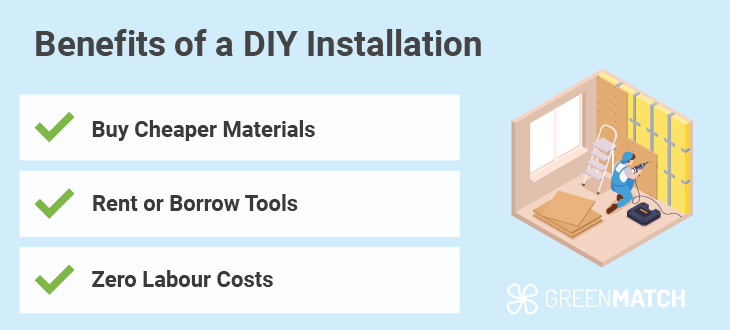
If you are truly confident in your handyman skills, did your research, and know of the regulations in place, a DIY installation can save up to three times the costs of a professional installer, making it a tempting option to consider.
It’s important to remember that cavity wall and external wall insulation shouldn’t be attempted as DIY projects given their complexity and requirement for industry-specific equipment. However, internal wall insulation can be considered relatively DIY-friendly.
Here are the main ways you can expect to save some money by carrying out a DIY internal wall insulation:
- Buy cheaper materials: Installing DIY gives you the control to fully decide which insulation materials you opt for, and how suitable they are to your budget. This doesn’t always mean you’ll land cheaper materials, but you’ll have the freedom to choose.
- Rent or borrow tools: Instead of paying upfront costs to an installation company for their tools, you can cut corners by renting for cheaper, or borrowing a set of tools from friends and neighbours.
- Zero labour costs: Perhaps the biggest financial advantage, you won’t have to pay for any labour costs. Up to 60% of the cost of internal wall insulation is for labour, so this can add up to some impressive savings.
Your costs and efforts can fluctuate based on whether you do dry lining or stud walls for your internal wall insulation, as discussed earlier in the article.
Homes with stud walls in place can easily be insulated by fitting insulating material in between the gaps, but building stud walls from scratch is a job better left to a professional installer.
What are the pros and cons of cheaper insulation materials?
There’s a wide range of insulation materials available on the market, suited for every budget and purpose. Some of these materials are even eco-friendly, sustainable, and entirely recyclable.
As a general rule, a pro for more expensive insulation materials is that they have a higher heat retention capability, making them far more efficient. However, a con is that this does not always make them eco-friendly or sustainable.
A good example of this is Polyurethane foam. Whilst being one of the most expensive and effective insulating materials on the market, the toxic chemicals and airborne fumes released in its application make it one of the most unsustainable and potentially harmful choices.
For a full understanding of the options on the market, let's start with materials for internal and external wall insulation, as well as their average costs per m2:
| Insulating material | Used for | Average cost (per m2) |
|---|---|---|
| PIR board | Internal / External | £5 – £15 |
| Fibreglass | Internal | £10 |
| (EPS) Polystyrene board | Internal / External | £10 |
| Cellulose | Internal | £10 - £12 |
| (Glass) Mineral Wool | Internal | £13 - £17.5 |
| Cork board | Internal / External | £17 - £22 |
| Sheep wool | Internal | £17.5 - £22 |
| (Rock) Mineral Wool | Internal | £18.2 |
| Polyurethane board | Internal / External | £21.5 |
For cavity fill insulation, a different set of materials is used for the job given the nature of the installation process. Three main types of insulating material are suited for this job; blown mineral wool, polystyrene beads, and expanding foam:
| Insulating material | Used for | Average cost (per m2) |
|---|---|---|
| Mineral wool blown insulation | Cavity walls | £13 - £18 |
| Polystyrene beads | Cavity walls | £18 - £22 |
| Polyurethane foam | Cavity walls | £22 - £26 |
In terms of eco-friendliness, options like mineral wool, cellulose and sheep wool offer an affordable yet effective option for internal walls that will also not run the risk of releasing harmful chemicals and VOCs into your home, as seen with some synthetic insulators.
For both internal and external wall insulation, cork boards are a great sustainable alternative to synthetic insulation boards like PIR or EPS Polystyrene.
In cavity walls, mineral wool blown insulation is by far the most eco-friendly and affordable approach to insulating your walls, while polyurethane foam may run the risk of releasing harmful toxins and VOCs into the atmosphere during and after installation.
Is wall insulation worth it?
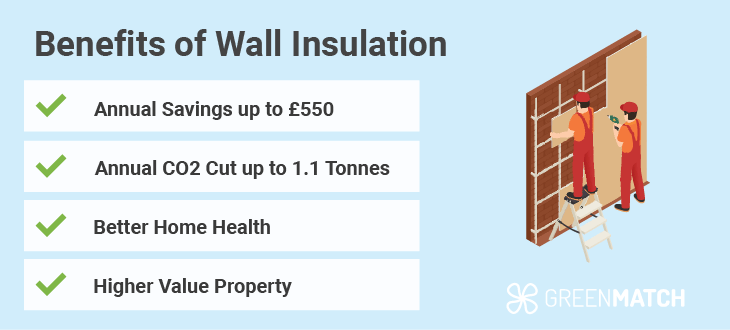
Wall insulation is arguably one of the most ‘worth it’ home upgrades you could invest in. By cutting your home heat loss by up to 33%, wall insulation can result in massive improvements to your home, finances and personal life. Here are just a few to consider:
- Big savings: Complete wall insulation ensures that your heating system doesn’t need to work as hard to regulate your home temperature. In a detached house, this can lead to energy bill savings of up to £550 every year.
- Eco-friendly: Cutting one-third of your home heat loss will drastically reduce your carbon footprint by up to 1.1 tonnes every year in a detached house. This is a massive contribution to a cleaner, healthier atmosphere across the UK and beyond.
- Improved home health: Draughty and damp homes are a festering ground for mould and rot. Alongside causing structural damage to your home, mould can lead to chronic respiratory illnesses. Insulated walls help protect your personal and home health.
- Higher value property: Homes with higher Energy Performance Certificate (EPC) ratings are valued much better in the housing market. By investing in wall insulation, you invest in the future of your property should you ever choose to rent or sell it.
Ready to get your home insulated? Look no further than GreenMatch UK to free you from all the hours of burdensome research and installer vetting. Through our services, you can gain access to our network of trusted installers and land the best bargain for your home.
Simply fill out our quick 30-second online form, and receive up to 3 free home-tailored quotes from accredited installers right in your area. No hidden charges or obligations apply. Click below to begin!
- Describe your needs
- Get free quotes
- Choose the best offer
It only takes 30 seconds



FAQ
According to estimates by the Energy Saving Trust and Royal Institution of Chartered Surveyors (RICS), cavity wall insulation costs around £2700, external wall insulation costs around £12,000 – £13,000, and internal wall insulation can cost around £7,500 for a standard semi-detached UK home. Wall insulation costs can fluctuate depending on your home type, size and installation complexity.
Cavity wall insulation typically costs around £7,400 for a standard 3-bedroom semi-detached home in the UK. Your final investment will vary depending on your opted insulation material, as well as insulation complexity. Using an online cavity wall insulation cost calculator with your home dimensions and location can better determine an accurate ballpark figure.
On average, external wall insulation costs around £12,000 to £13,000 for a standard semi-detached UK home. However, just like with any insulation project, several factors may cause this price range to fluctuate.
To be eligible for an insulation government grant, you generally need to be in a low-income household, live in a home with an EPC rating below D, or receive certain government benefits. For a full picture of what it takes to qualify for a wall insulation grant, consult the official UK government portal.

Akif is a copywriter at GreenMatch since 2023. With a keen interest in community sustainability, green solutions and the role of digital media in identifying climate trends, he aims to hone in on his background in International Studies and Digital Media to provide a multidisciplinary approach to written content rooted in credible research and accuracy.
We strive to connect our customers with the right product and supplier. Would you like to be part of GreenMatch?

